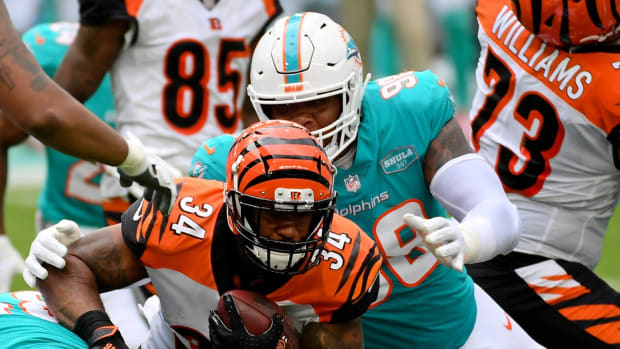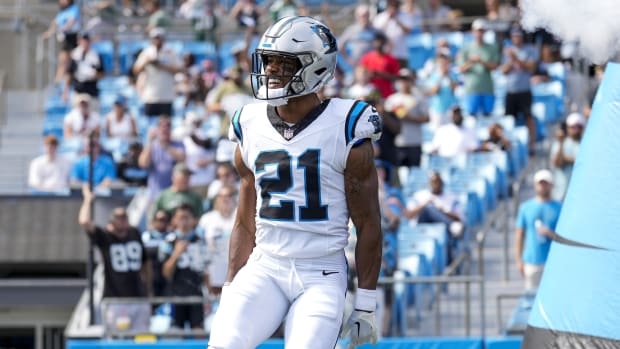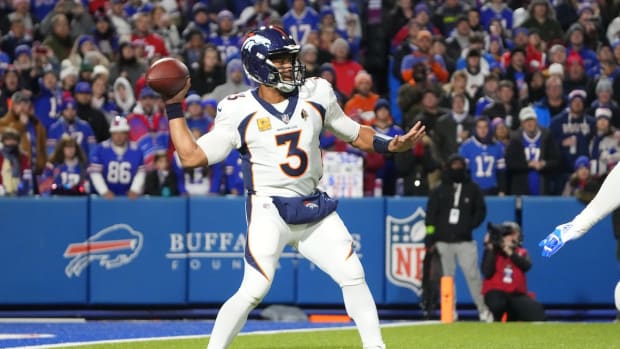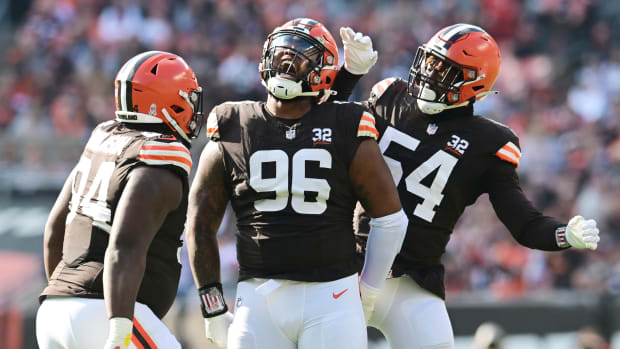The Bears’ QB Method Isn’t Madness, and More Mid-May NFL Notes
1. I think the Bears’ 2017 approach to finding a quarterback is one you won’t have to wait too long to see again, because you don’t have to go very far back to see where another club used it. A year ago the Eagles took a lot of heat for giving $25 million per year in contracts to Sam Bradford and Chase Daniel, only to trade up twice to draft Carson Wentz. And you know what? If Wentz becomes who the Eagles think he will become, and who it looked like he could become early in 2017, then no one will remember any of that. Just like no one remembers that Jimmy Johnson forfeited the first overall pick in the 1990 draft in the previous year’s supplemental draft, selecting Steve Walsh months after he took Troy Aikman first overall. Yes, the Teddy Bridgewater injury in Minnesota helped the Eagles mitigate the cost of all that quarterback business of last March and April. But rookie defensive end Derek Barnett (the windfall in the Bradford trade) won’t be what determines whether or not all that movement was a success. Wentz will. And the same goes for Mike Glennon and Mitch Trubisky in Chicago: If one or the other is still the Bears quarterback in 2030, what GM Ryan Pace did in 2017 will all have been worth it. If he’s wrong? Well, getting that position wrong gets people fired all the time, and this would be no different.
2. I think the case of Reuben Foster will be fascinating to follow over the next few months. Some teams looked at his shoulder as enough of an issue that, had they drafted him, they’d have immediately told him to get his surgery redone—feeling that the initial surgery didn’t take. But just as significant were the off-field elements at play. What puts the Niners, who moved up to draft Foster with the 31st pick, in a good spot in that regard is geography. San Francisco is a long way from Foster’s hometown of Auburn, Ala. Going into the draft, the feeling was that the further Foster landed away from home, the better. He had a very rough upbringing, and some teams were concerned about the crowd he grew up with. In a certain way, that situation made him a little like Dez Bryant. Before the 2010 draft, most people figured the two places Bryant, a native Texan, couldn’t land were Houston and Dallas. He, of course, went to the Cowboys, but the Dallas brass put a ton of resources into making sure Bryant didn’t fall back into some of the trouble that scared NFL types when he was at Oklahoma State. Obviously it worked out, but it hasn’t always been easy. The Niners are in a better spot with Foster. And if his shoulder needs to be redone, well, it’s not like John Lynch and Kyle Shanahan don’t have a little time to wait on him, given the rebuild ahead.
3. I think I’ve beaten the dead horse on this already, but good on the Niners and Browns and Jets for not forcing it in 2017, with a potentially rock-solid 2018 quarterback class coming—Sam Darnold, Josh Allen and Josh Rosen could be the top three picks in the draft, and Kirk Cousins and Jimmy Garoppolo might be available on the veteran market. So the Jets will get some answers on 2016 second-rounder Christian Hackenberg, through the tutelage of position coach/QB savant Jeremy Bates, in the meantime; the Browns will figure out more about Cody Kessler or DeShone Kizer; and the Niners can build their infrastructure up a little bit to create a better environment for whomever the long-term quarterback is. And by passing on quarterbacks, each of those three teams took advantage of an unusually strong defensive draft. The Jets got safeties Jamal Adams and Marcus Maye; the Niners got front-seven pieces Solomon Thomas and Foster; and the Browns landed two athletic freaks in Myles Garrett and Jabrill Peppers.
4. Tom Brady’s thrown out the number “45” before when asked to what age he wants to keep playing, and he offered it up again to ESPN’s Ian O’Connor the other day. Drew Brees has used that number before. So has Andy Dalton. And I think I know where they got the number 45 from: major league pitcher-turned-quarterbacking guru Tom House. And House got it through working with the once-seemingly-ageless Nolan Ryan. House’s conclusion, through coaching Ryan and studying the science of rotational athletes (i.e. anyone who throws or swings competitively), is that proper training and nutrition, and some luck avoiding injury, should allow a quarterback to go until he’s 45. His assertion is that it’s then that recovery makes it too difficult to maintain an elite-level performance. In other words, at that point it takes too long to bounce back from playing to continue training and preparing the way you’d need to at that age. At this point, we don’t know if he’s right. We also don’t know if he’s wrong, since Brady and Brees would be the first test cases.
• TOM BRADY IN MONTANA: Peter King’s exclusive post-Super Bowl sitdown with the Patriots QB
5. I think the Bengals’ draft looked very much like a Bengals draft, and that means two things: a) Risk was involved, and b) an effort to catch talented athletes who were falling was made. Their first two guys carry significant “if’s”. Washington dynamo John Ross could make A.J. Green and Tyler Eifert much more difficult to defend, if he can stay healthy and become the DeSean Jackson-type weapon scouts envisioned him being in evaluating him the last couple years. And Joe Mixon could change the face of the entire offense as a 230-pound, three-down back if he’s the guy Oklahoma coaches swore to teams he became over the last three years, and what we all saw on that unsightly video of July 2014 proves to be an isolated incident. Bottom line, the ceiling is high for what Ross and Mixon could do for Andy Dalton, with Green and Eifert already on hand. And after that, the Bengals filled their pass-rush need by catching Kansas State’s Jordan Willis and Auburn’s Carl Lawson at 73 and 116, respectively, which is not unlike how they wound up with Geno Atkins and Carlos Dunlap years ago. For better or worse, this is how Cincinnati built its team into one that made the playoffs five straight years, and hitting on these guys could mean returning there after missing out in 2016.
• THE FINE PRINT OF ROOKIE CONTRACTS: Andrew Brandt on the reality behind those contract numbers
6. 6. I think you should pay attention to Brian Gaine’s move from Houston to Buffalo as VP of player personnel. It caused a ripple in NFL circles. For one, good on Buffalo GM Brandon Beane for moving quickly in a very difficult circumstance, having to fill out an entire scouting staff on the fly. Gaine is a seasoned scout, worked for years with new assistant GM Joe Schoen, and will help Beane and coach Sean McDermott in aligning the organization, which brings us to what the Texans will miss. As for Houston, overOver the last few years Gaine was vital as a power broker on the personnel side, because his strong relationships with the bulk of Bill O’Brien ‘s staff made him a liaison between coaching and scouting in an organization where everyone hasn’t always been on the same page. That’s a void that may be tough to fill, and it’ll be interesting seeing where that leaves the Texans after the 2017 season.
7. I think if I’m going to have a rational conversation about Colin Kaepernick, I’d have to start with what I know. And that’s that Kaepernick’s unemployment begins with the deterioration of his football value. You can ascertain that by asking yourself a really simple question: If Kaepernick became the player we thought he’d be four years ago, and he was a free agent now, with all the activism attached, how long would it take him to find work? Answer: about 5 seconds, or however long it took him to push the button to accept an incoming call on his cell. Now, if we take that down a notch, and just say he’s viewed as an intriguing long-term option at the position, and ask the same question, what’s the answer? Yeah, it wouldn’t take long for him to get a job in that spot either. The trouble for him begins there, at least as far as I can tell through just about every discussion I’ve had with NFL evaluators about this. He’s in the veteran stopgap/backup group. That’s where his activism becomes a factor.
8. I think if you want to make the argument about Kaepernick’s 16-4 TD-INT ratio in 2016, I’d point out that his 187 passing yards per game put him 30th among 30 qualifying quarterbacks in 2016, his 6.77 yards per attempt was 24th among qualifiers, he was 1-10 as a starter, and he was playing in a scheme that was ideal for his skill set. Was he bad? No, and he didn’t have a good team around him. Could he improve those numbers in a traditional offense? Debatable at best, considering how things went in 2014 and ’15, and because he hasn’t shown he can in six years as a pro. And if you accept he’s in that vet stopgap/backup category (again, that’s where every coach or scout I’ve talked to has him), that becomes a bigger issue. No one is building his system around a backup, and no one wants to have change everything for the other 10 players in the huddle if the starter goes down. And yes, his activism takes on different context if he’s a backup. Call it a circus. Call it a distraction. Call it offensive to call it circus or a distraction. The bottom line is if you sign him, you’ll have satellite trucks lining up at your facility from day one. Coaches don’t like that stuff in any circumstance but are willing to manage it if it’s the third or fourth guy on their roster. If it’s a backup, meaning the 30th or 40th guy? Well, that’s where it’s much easier to just bring in someone like Matt Barkley.
9. Want an underrated rookie to look out for? Keep an eye on Rams second-round pick Gerald Everett, out of South Alabama. A couple other teams groaned when they saw him come off the board with the 44th pick, thinking he’d slip to them later in the second round. And the way the team sees it, Everett should fit new coach Sean McVay’s offense the same way that Jordan Reed did in Washington, which certainly wouldn’t hurt the effort to help Jared Goff make a big leap in his second year.
10. I think we mentioned in last Thursday’s Game Plan why the Dolphins skipped doing a full on rookie minicamp two weekends ago—coach Adam Gase doesn’t see the value in practicing against the injury risk of throwing his draft picks out there with a bunch of tryout players, and everyone coming off of four months of training for a track meet, rather than a football season. Instead, Miami had an orientation weekend, stocked with meetings and walkthroughs. It’s how Gase did it in 2016, too. And by the looks of it, it seems Gase’s staff was sold on the idea. One way to tell? New Broncos coach Vance Joseph—Gase’s defensive coordinator last year—had a similar orientation, in lieu of a traditional camp, with his rookies last weekend in Denver.
Question or comment? Email us at talkback@themmqb.com.





































